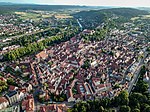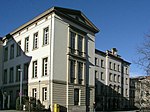St. George's Collegiate Church, Tübingen
15th-century churches in GermanyBaden-Württemberg building and structure stubsBuildings and structures completed in 1470Buildings and structures in TübingenBurial sites of the House of Württemberg ... and 5 more
Churches of the Evangelical-Lutheran Church in WürttembergFormer collegiate churchesGerman church stubsLutheran churches converted from Roman CatholicismTourist attractions in Tübingen

The Stiftskirche is a church located in Tübingen, Baden-Württemberg, Germany. It is a late Gothic structure built by Peter von Koblenz in 1470. The stained glass windows were designed by Peter Hemmel of Andlau who also designed windows in Ulm, Augsburg, Nuremberg, Munich and Strasbourg. It is the central landmark of Tübingen and, along with the rest of the city, the Stiftskirche was one of the first to convert to Martin Luther's Protestant church. It maintains (and carefully defends) several "Roman Catholic" features, such as patron saints. Tower music is played from the church tower every Sunday.
Excerpt from the Wikipedia article St. George's Collegiate Church, Tübingen (License: CC BY-SA 3.0, Authors, Images).St. George's Collegiate Church, Tübingen
Münzgasse,
Geographical coordinates (GPS) Address Website External links Nearby Places Show on map
Geographical coordinates (GPS)
| Latitude | Longitude |
|---|---|
| N 48.52 ° | E 9.0561111111111 ° |
Address
Stiftskirche St. Georg
Münzgasse 32
72070 , Universität
Baden-Württemberg, Germany
Open on Google Maps










